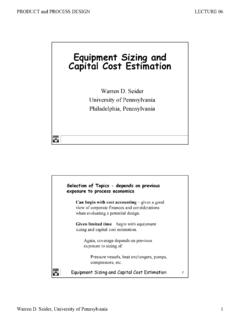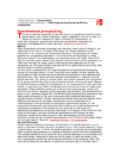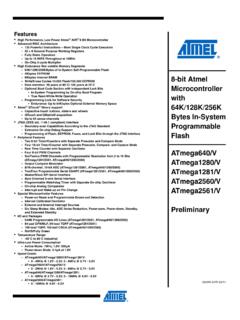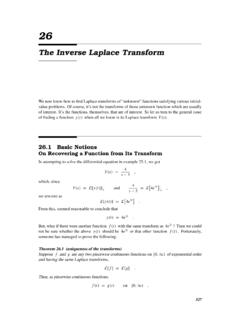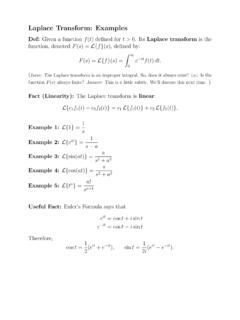Transcription of Laplace Transforms with MATLAB - seas.upenn.edu
1 Laplace Transforms with MATLAB a. Calculate the Laplace transform using MATLAB Calculating the Laplace F(s) transform of a function f(t) is quite simple in MATLAB . First you need to specify that the variable t and s are symbolic ones. This is done with the command >> syms t s Next you define the function f(t). The actual command to calculate the transform is >> F= Laplace (f,t,s) To make the expression more readable one can use the commands, simplify and pretty. here is an example for the function f(t), )( ++ = >> syms t s >> f= + *t*exp(-2*t)+ *exp(-2*t); >> F= Laplace (f,t,s) F = -5/4/s+7/2/(s+2)^2+5/4/(s+2) >> simplify(F) ans = (s-5)/s/(s+2)^2 >> pretty(ans) s - 5 ---------- 2 s (s + 2) which corresponds to F(s), 2)2()5()(+ =ssssF Alternatively, one can write the function f(t) directly as part of the Laplace command: >>F2= Laplace ( + *t*exp(-2*t)+ *exp(-2*t)) ESE216 1 b.
2 Inverse Laplace transform The command one uses now is ilaplace. One also needs to define the symbols t and s. Lets calculate the inverse of the previous function F(s), 2)2()5()(+ =ssssF >> syms t s >> F=(s-5)/(s*(s+2)^2); >> ilaplace(F) ans = -5/4+(7/2*t+5/4)*exp(-2*t) >> simplify(ans) ans = -5/4+7/2*t*exp(-2*t)+5/4*exp(-2*t) >> pretty(ans) - 5/4 + 7/2 t exp(-2 t) + 5/4 exp(-2 t) Which corresponds to f(t) )( ++ = Alternatively one can write >> ilaplace((s-5)/(s*(s+2)^2)) Here is another example. )54()2(10)(2+++=sssssF >> F=10*(s+2)/(s*(s^2+4*s+5)); >> ilaplace(F) ans = -4*exp(-2*t)*cos(t)+2*exp(-2*t)*sin(t)+4 Which gives f(t), )()]sin(2)cos(44[)(22tutetetftt + = making use of the trigonometric relationship, )/(tan)cos()sin()cos()sin()cos()sin(122x yyxRwithRyxandRyx =+=+= +=+ One can also write that f(t) )()] ( [2tuteot += ESE216 2 MATLAB often gives the inverse Laplace transform in terms of sinhx and coshx.
3 Using the following definition one can rewrite the hyperbolic expression as a function of exponentials: 2)sinh(xxeex += 2)cosh(xxees = Also, you may find the Heaviside(t) function which corresponds to the unit step function u(t): thus the function H(t) = heaviside(t) =0 for t<0 and H(t) = heaviside(t)=1 for t>0. As an example, suppose that MATLAB gives you the following result for the inverse Laplace transform : 2 heaviside(t-10) exp(-5/2t+25) sinh(1/2t-5) This can be re-written, using the definition of the sinh(x) function: 2u(t) )10(][])[10().10(]2[).10(2)()10(3)10( )10( = = = = + + + + ++ + tueeeetueetueeetutfttttttttttt This last expression is closer to what your hand calculations will give you for the invers Laplace transform . ESE216 3
